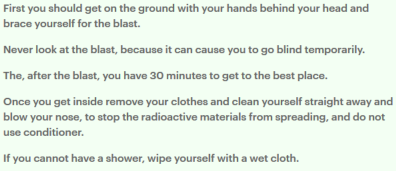 gainst the advice of his conservative base, President Trump has once again sent
missiles into Syria in response to an alleged chemical attack. The Russians, showing
a new-found sense of self-preservation, evacuated beforehand, and so far we've avoided
WWIII, which is nice.
gainst the advice of his conservative base, President Trump has once again sent
missiles into Syria in response to an alleged chemical attack. The Russians, showing
a new-found sense of self-preservation, evacuated beforehand, and so far we've avoided
WWIII, which is nice.
First of all, was it really chlorine? News reports showed Syrians running around in a fog- or smoke-filled environment, something that is very unlikely if the fog is chlorine. Those pictures resembled smoke rather than chlorine. (In some later pictures, the green channel was enhanced to make chlorine seem more plausible.) Other pictures show children, some evidently dead, with foaming mouths, which would also be inconsistent with chlorine. This is literally the famous fog of war.

Daily Mail's tips on what to do if there's a nuclear blast
One video on the Internet shows similar children in a “drill” showing rescuers putting fake foam on their mouths. One actor wearing a gauze mask pretends to get knocked out after trying to resuscitate one of the children. Whether that video was the same as the one used by the news media is unclear.
The news media consistently using fake footage and getting technical details wrong does not inspire confidence in their reporting skills. MSNBC incorrectly called chlorine a nerve agent. The Washington Post misleadingly reported that chlorine turns into hydrochloric acid in the lungs. Even the Daily Mail, a bastion of mostly-grammatical English and, on occasion, accurate, thoughtful reporting, claimed that people were panicking about World War III, and so provided a helpful list of tips to protect yourself against an H-bomb attack, which included lying on the ground and not using conditioner.
Good advice. Truly, it would be a bad hair day, but not using conditioner would just make it worse.
Why is chlorine toxic?
The immediate effect of chlorine is uncontrollable spasmodic coughing. According to the US Government's Medical Aspects of Chemical and Biological Warfare, about 2–4 hours after exposure the victim develops pulmonary edema and dyspnea. Vomiting often occurs, with a distinctive odor of chlorine. When sudden death occurs it is thought to be secondary to laryngeal spasm.
When chlorine dissolves in water, it produces hypochlorous acid (HOCl) and hydrochloric acid (HCl). The HCl is certainly not good for you, but the toxicity is primarily due to direct oxidation of biomolecules, not to acidity. Carlisle et al. describe it this way:
Upon inhalation, Cl2 first reacts with antioxidants in lung epithelial lining fluid (ELF). Once antioxidant stores are depleted, soluble Cl2 rapidly undergoes hydrolysis to generate hypochlorous (HOCl) and hydrochloric acids (HCl). These Cl2 products then react with protein side chains, DNA, and lipids of the cells that line the airway epithelium to generate toxic reactants. Some of these reactants formed are long lasting, contributing to injury long after the duration of the initial exposure event. Chloramines generated by Cl2 reactions with proteins activate inflammatory cascades through the mitogen-activated protein kinase (MAP kinase) and the nuclear factor κ light chain enhancer of activated B cells (NF-κB) pathways, resulting in inflammatory cell infiltration into the alveolar space. . . . In addition, chlorinated lipids (sterols, fatty acids, and phospholipid chlorohydrines generated from reactions with Cl2 or HOCl) are considered proinflammatory. (Carlisle et al., Chlorine-induced cardiopulmonary injury. Ann NY Acad. Sci 2016, 1374(1), 159–167; minor errors corrected.)
The Washington Post may be thinking of phosgene, which hydrolyzes to free HCl in the larynx, where it causes laryngospasm, and in the lungs. (As for phosgene, there is still debate about its exact mechanism; it's an oxidant, alveolar irritant, and inflammatory agent. It reduces levels of glutathione (an antioxidant) and increases the levels of inflammatory lipoxygenase products such as leukotrienes.)
If chlorine's toxicity were due to hydrochloric acid, hydrogen chloride gas would be a more efficient way of delivering it. But it is never used.
These fake bits of news aren't harmless. They create myths that could be deadly if someone tried to protect themselves using the false information. It's easy enough to check these facts. It's not enough to just check Winkypedia.
Tomahawk missiles
Besides the obvious parallels to Bill Clinton's aspirin factory dipsy-doodle, the proximate trigger for launching these missiles might have been Russia's claim that its anti-missile system can shoot them down. Saying this to someone in our military-industrial complex is like waving a raw steak in front of a tiger: it provides an priceless opportunity to test the technology against a serious potential adversary in a real world scenario.
As Douglas Macgregor points out, many of those urging Trump to take action were members of the deep state, his most intransigent enemy. Trump's attack was more of a signal against the principle of using chemical weapons than anything else.
The Syrians claimed to have shot down 13 of the Tomahawk missiles. The Russians claimed to have shot down 71 of 103 launched (actually there were 105). Whether these claims are really true or not, the MIC now has a clear mandate: make them stealthier, and design them to fly closer to the ground. They'll need more funding to do that, for the next time.
The response to all these claims from both sides ought to be: evidence or it didn't happen.
apr 14 2018, 7:29 am. edited apr 18 2018, 4:37 pm
